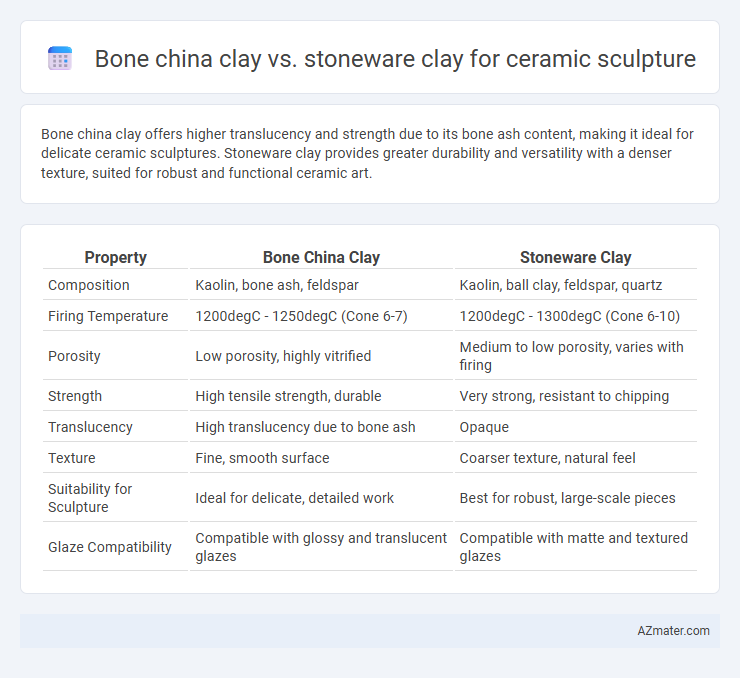Bone china clay offers higher translucency and strength due to its bone ash content, making it ideal for delicate ceramic sculptures. Stoneware clay provides greater durability and versatility with a denser texture, suited for robust and functional ceramic art.
Table of Comparison
| Property | Bone China Clay | Stoneware Clay |
|---|---|---|
| Composition | Kaolin, bone ash, feldspar | Kaolin, ball clay, feldspar, quartz |
| Firing Temperature | 1200degC - 1250degC (Cone 6-7) | 1200degC - 1300degC (Cone 6-10) |
| Porosity | Low porosity, highly vitrified | Medium to low porosity, varies with firing |
| Strength | High tensile strength, durable | Very strong, resistant to chipping |
| Translucency | High translucency due to bone ash | Opaque |
| Texture | Fine, smooth surface | Coarser texture, natural feel |
| Suitability for Sculpture | Ideal for delicate, detailed work | Best for robust, large-scale pieces |
| Glaze Compatibility | Compatible with glossy and translucent glazes | Compatible with matte and textured glazes |
Introduction to Bone China Clay and Stoneware Clay
Bone china clay, composed primarily of kaolin, feldspar, and bone ash, offers exceptional translucency, strength, and a fine, smooth texture ideal for delicate ceramic sculptures. Stoneware clay, rich in alumina and silica, is known for its durability, high firing temperature tolerance, and versatility, making it suitable for robust and functional ceramic pieces. Both clays present distinct firing ranges and surface finishes, with bone china achieving a glass-like translucency at lower temperatures compared to the dense, often more textured results of stoneware fired at higher temperatures.
Composition Differences Between Bone China and Stoneware
Bone china clay contains a significant amount of bone ash, typically 30-45%, combined with kaolin and feldspathic materials, creating a translucent, white, and strong ceramic body ideal for delicate sculptures. Stoneware clay is composed primarily of kaolin, ball clay, and feldspar, fired at higher temperatures to produce a dense, durable, and non-porous body with a more opaque and earthy texture. The key compositional difference lies in the high bone ash content of bone china, which imparts translucency and whiteness, contrasting with the robust, stone-like characteristics of stoneware clay.
Workability and Sculpting Properties
Bone china clay offers exceptional plasticity and a smooth texture, making it highly suitable for intricate ceramic sculpture details and fine modeling work. Stoneware clay features coarser particles, providing greater strength and durability but requiring more effort for detailed sculpting due to its lower plasticity. Workability in bone china clay supports delicate, precise forms, while stoneware clay excels in robust, structural sculptures that withstand firing stress.
Firing Temperatures and Techniques
Bone china clay requires lower firing temperatures, typically between 1200degC and 1300degC, making it ideal for delicate ceramic sculptures with fine details and translucency. Stoneware clay is fired at higher temperatures, ranging from 1200degC to 1300degC but generally more robust and less translucent, offering greater durability and strength for functional or heavyweight sculptural pieces. Techniques for bone china often involve careful control of kiln atmosphere to preserve translucency, while stoneware firing favors stone-like hardness achieved through longer or hotter firings.
Durability and Strength Comparison
Bone china clay offers superior strength and durability due to its high feldspar and bone ash content, resulting in a strong, vitrified structure ideal for fine, delicate ceramic sculptures. Stoneware clay is also highly durable, characterized by its dense, non-porous nature after firing at high temperatures, making it ideal for robust, functional sculptures resistant to chipping and cracking. While bone china excels in translucency and refinement, stoneware provides greater toughness and resilience, making the choice dependent on the desired balance between delicate detail and rugged durability.
Surface Finish and Texture Results
Bone china clay offers a smoother, more refined surface finish due to its fine particle size and high kaolin content, resulting in a translucent, delicate appearance ideal for detailed ceramic sculptures. Stoneware clay provides a more robust, textured surface with a naturally grainy feel that enhances rustic and earthy aesthetics, suitable for larger, more durable pieces. The vitrification temperature of stoneware also contributes to a denser, less porous texture compared to the lighter, more porous finish of bone china clay.
Color and Glaze Compatibility
Bone china clay offers a translucent, smooth surface ideal for vibrant, detailed color applications, enhancing glaze clarity and luminosity in ceramic sculpture. Stoneware clay features a denser, more textured body that naturally absorbs glaze differently, producing earthy, matte finishes with richer, muted tones. Both clays provide distinct aesthetic possibilities, with bone china excelling in bright, glossy glazes and stoneware supporting robust, varied glaze textures and color depth.
Suitability for Detailed Sculpture Work
Bone china clay offers exceptional plasticity and smooth texture, making it ideal for detailed ceramic sculpture requiring fine, intricate features. Stoneware clay, while durable and strong, tends to be coarser and less responsive to delicate modeling, limiting its effectiveness for highly detailed work. Artists seeking precision and delicate detail often prefer bone china clay due to its superior workability and refined surface finish.
Cost and Accessibility of Both Clays
Bone china clay typically costs more due to its refined composition and higher purity, making it less accessible for beginners and hobbyists. Stoneware clay is more affordable and widely available at most art supply stores, offering greater accessibility for ceramic sculptors at various skill levels. The choice between bone china and stoneware clay often hinges on budget constraints and ease of obtaining materials.
Choosing the Right Clay for Ceramic Sculpture Projects
Bone china clay offers a refined texture and high plasticity, making it ideal for delicate ceramic sculptures requiring intricate detail and a translucent finish. Stoneware clay provides greater durability and strength, suited for larger or functional sculptures needing robust structural integrity and resistance to chipping. Selecting the right clay depends on the sculpture's intended purpose, desired finish, and firing temperature compatibility, with bone china favoring low firing ranges and stoneware excelling in high-temperature durability.

Infographic: Bone china clay vs Stoneware clay for Ceramic sculpture
 azmater.com
azmater.com